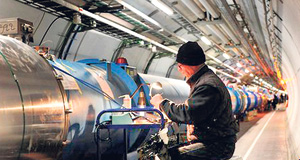The organisation that operates the Large Hadron Collider has set a date for the start of its science programme.
On Tuesday March 30, engineers at Cern will make their first attempt to collide beams at an energy of 3.5 trillion electronvolts (TeV) per beam.
The LHC reached this beam energy last week, breaking its own particle beam energy record.
But, among other things, engineers will need to ensure the beams are stable at 3.5 TeV before trying for collisions.
The LHC will search for the elusive Higgs boson, dubbed the "God particle" because of its importance to our understanding of physics.
"Symbolically, the start of the LHC research programme is when we start systematically colliding beams for physics at the energy we have chosen for this year," Cern's director of communications Dr James Gillies, told BBC News.
"That's what we're hoping for a week today."
Steve Myers, director for accelerators and technology at Cern, explained: "With two beams at 3.5 TeV, we're on the verge of launching the LHC physics programme.
"But we've still got a lot of work to do before collisions. Just lining the beams up is a challenge in itself. It's a bit like firing needles across the Atlantic and getting them to collide half way."
'Golden orbit'
The experiment, housed in a 27km-long tunnel under the Franco-Swiss border near Geneva in Switzerland, has only been back online since November 2009.
A magnet fault caused one tonne of liquid helium to leak into the tunnel in 2008, shortly after the machine was first switched on, requiring a programme of repairs that lasted 14 months.
Between now and 30 March, the LHC's team will be working to commission the beam control systems and the systems that protect the machine's detectors, or experiments, from stray particles.
 |
| A scientist at work at LHC which is being used to smash together beams of proton particles in a bid to shed light on the nature of the Universe |
All these systems must be fully commissioned before collisions at 3.5 TeV can begin, Cern says. "Getting beams circulating is one thing. Having them circulate for a reasonable lifetime is another. Having a 'golden orbit' - where the beams complete lap after lap after lap for hours - is important," Dr Gillies said.
"All of these things you have to do before the machine operators can say: 'the beams are now stable, you can switch on the detectors."
The LHC is being used to smash together beams of proton particles in a bid to shed light on the nature of the Universe.
Some 1,200 superconducting magnets bend proton beams in opposite directions around the tunnel at close to the speed of light.
At allotted points around the tunnel, the proton beams cross paths, allowing particles to smash into one another.
Detectors located at the crossing points will scour the wreckage of these collisions for discoveries that extend our knowledge of physics.
WHAT IS AN ELECTRON VOLT?
- Charged particles tend to speed up in an electric field, defined as an electric potential - or voltage - spread over a distance
- One electron volt (eV) is the energy gained by a single electron as it accelerates through a potential of one volt
- It is a convenient unit of measure for particle accelerators, which speed particles up through much higher electric potentials
- The first accelerators only created bunches of particles with an energy of about a million eV (MeV)
- The LHC can reach beam energies a million times higher: up to several teraelectronvolts (TeV)
- This is still only the energy in the motion of a flying mosquito
- But that energy is packed into a comparatively few particles, travelling at more than 99.99% the speed of light
Courtesy bbc.co.uk
|


